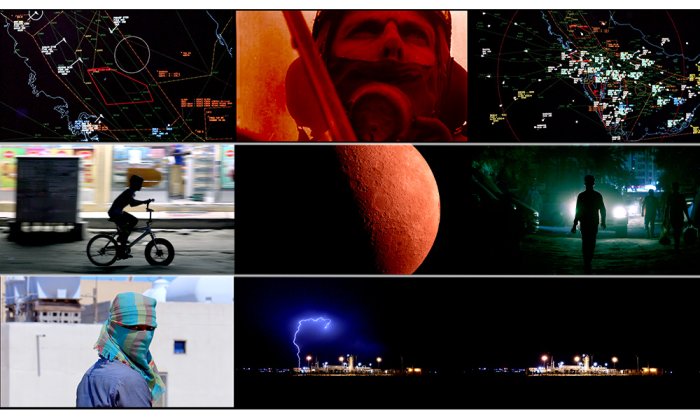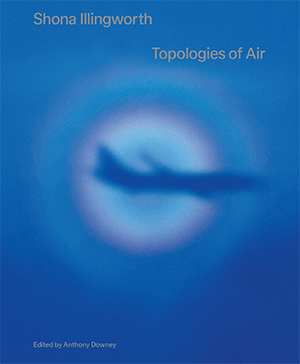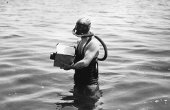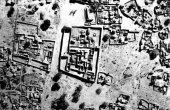Calculating Skies: Topologies of Air and the Airspace Tribunal

From the opening shots of “Topologies of Air,” Shona Illingworth’s three-screen video and sound installation, we are presented with a restricted view of the sky. Broadly associated with expansiveness, if not freedom, this distilled vista suggests an overdetermined environment that is subject to competing interests — be they national, military-industrial, or economic — that often remain impenetrable to observers.
This is a vision of a claustrophobic firmament, a partitioned dome of airspace that is endlessly quartered through the interventions of all-consuming, mercenary systems of power and control. Under these conditions, and to ensure that national, military-industrial, and commercial interests are preserved, the apparent immateriality of airspace needs to be rendered both material and calculable. Fought over, allocated, and reserved, the substance of air must be not only quantifiable but also an instrumental element in the production of data, the maintenance of hegemony, and the projection of power.

The systems that calculate the substance of air are increasingly autonomous apparatuses, as in the case of drone technologies and Lethal Autonomous Weapons (LAWs). Through satellite surveillance systems, the command of such armaments is evident in the effect they have on the communities that are subject to their disciplinary practices. The unprecedented development of aerial surveillance technologies and LAWs, aided by advances in Artificial Intelligence (AI), effectively constitute an evolving regime of power and domination that further establishes the realities of neocolonial forms of subjugation. This process not only amplifies already existing disparities in disciplinary forms of power — based on the extraction and repurposing of data — but renders entire communities susceptible to the invariably devastating, if not catastrophic, impact of an unchecked military-industrial takeover of extraterrestrial space. Whereas colonial occupation was once largely achieved through actual invasion, it is now inevitably realized through the application of advanced surveillance systems and drone-led infractions of international law.
Whereas colonial occupation was once largely achieved through actual invasion, it is now inevitably realized through the application of advanced surveillance systems and drone-led infractions of international law.
All of which leaves us with a pressing question: How do we effectively understand the real-world implications of these air-bound technologies in an age where we appear to be devolving our responsibility for the decisions that determine the difference between life and death? Furthermore, how do we understand the colonization of airspace and outer space in the context of the diverse cosmologies and cultural histories that shape our relationship to the sky, not to mention the existential threats of climate change, catastrophic loss of biodiversity, and extractive capitalism? It is toward these complex entanglements that Illingworth directs her practice, nowhere more so than in the consideration of how creative, interdisciplinary platforms can expand and support the development of a new legal argument — effectively, a proposal for a new human right — that critically engages with the accelerating military, chemical, territorial, and psychological transformations of airspace and outer space.
In foregrounding the escalating threat of actual physical harm for individuals and communities who are subject to satellite surveillance and LAWs, “Topologies of Air” is supported by extended forms of research, the input of legal experts, and a wide range of specialists in subjects including trauma and memory studies. This project, in sum, forms the basis for not only articulating a response to the many questions raised above but also a platform for ensuring further research — based on both lived experience and expert testimony — into the multiple concerns such interventions raise.
Across the three screens of “Topologies of Air,” which produce a series of contrapuntal effects amidst the images and commentary, a plurality of voices speaks of the vast toxic dust storms caused by war, devastating ecological degradation, the aftermath of nuclear bombing, the annihilation of chemical warfare, the deployment of drone swarms, the territorialization of the electromagnetic spectrum, the expansion of hostile surveillance, and the global governance issues of imminent, but yet-to-be realized, geo-engineering projects. These are interwoven with references to early fantasies about the liberatory context of flight and the diverse cultural understandings of the sky as a pluri-versal, if not ominous, space. Once a source of imaginative projection and wonder, “Topologies of Air” scrutinizes how the sky is rapidly transforming into a source of ontological insecurity and perpetual threat that pervades all aspects of planetary life and the traditional narratives that were once ascribed to its expanse.
Focused on the opacity of military-industrial interests and the operative logic of surveillance and other aerial technologies, the installation is indelibly informed by the international Airspace Tribunal, which was established by Illingworth and Nick Grief in 2018. A pioneering research project investigating the potential of a new human right to address accelerating threats from airspace and outer space, the Airspace Tribunal hearings brought together contributors with a wide range of expertise and lived experience to consider the case for and against the recognition of a new human right proposed by Illingworth and Grief. This human right would protect a person’s freedom to live without physical or psychological threat from above. If airspace is an area-based concept where states exercise jurisdiction, in relation to both aviation and defense, we need to account for — as Illingworth and Grief have argued — the complex, diverse ways in which the sky is used, impacted upon, or exploited. Crucially, we need to further examine how the sky is valued, understood, and experienced across different cultures now and, as we move forward with a proposal for a new human right.

Emphasizing how military technologies are imbricated within present-day and ongoing developments in airpower, the over-arching imperative here is to also consider the degree to which emerging technologies evoke, if not promote, forms of radical forgetting — or active forgetting — to legitimize their functioning, with our all too amenable compliance. Through increasing levels of abstraction, to what extent do these technologies further distance us from the realities of trauma, injury, despoliation, and death? It is with such points in mind that “Topologies of Air”and the Airspace Tribunal enquire into whether the moment of visualizing and formally articulating — through public hearings — the impact of air-bound technologies can not only reconceptualize the military-industrial-corporate entanglements of airspace, outer space, and environments but also, in so doing, hold them to account?
Through increasing levels of abstraction, to what extent do these technologies further distance us from the realities of trauma, injury, despoliation, and death?
Both “Topologies of Air” and the Airspace Tribunal also consider human rights as a “living instrument,” a phrase referred to in 2018 by Conor Gearty, the former director of the Centre for the Study of Human Rights at the London School of Economics at the inaugural Airspace Tribunal hearing at Doughty Street Chambers, London, and utilized by Illingworth to describe the performative element of a human right drawn from the lived experiences of those subjected to threat from above. As technologies evolve, so too does their threat, and human rights discourse needs to take account of such threats. When the legal debates surrounding the establishment of Article 3 of the Universal Declaration of Human Rights (1948) and Article 6 of the International Covenant on Civil and Political Rights (1966) were being formulated, they most likely did not foresee, to paraphrase General Michael Hayden’s utterance in 2014, that the U.S. military would one day kill people based on “metadata.” To address these historical lacunae and the imminence of aerial threat, the proposed new human right that the Airspace Tribunal hearings are considering would be formulated and adopted through international and domestic political processes with, crucially, the active involvement of diverse levels of expertise and the lived experience of those subjected to threat from above in our present-day.
We need, the Airspace Tribunal further proposes, to not only advocate for and instantiate a new human right to address these transformations of airspace and outer space but to also determine how aerial-bound threat — manifest in the hazards of nuclear power, exposure to climate change, and lethal aerial weapons — evolved out of multi-domain warfare policies in global military strategies. Throughout these hearings, this spectrum of threat is understood and discussed in a process that effectively challenges the traditional state-centric view of how international law is created. To these ends, “Topologies of Air”and theAirspace Tribunal jointly inquire into how qualitative (or creative) practices and epistemologies, alongside the quantitative (data-led) methods of evidence gathering, could expand upon, if not redefine, the legislative measures needed to address the existential threat caused by air-bound technologies.
The methodologies employed throughout Illingworth’s practice, conjoining as they do qualitative, aesthetic forms of inquiry (visual and aural analysis) and quantitative, material (evidentiary) approaches, actively promote an investigation in how visual cultures promote forms of knowledge exchange and transfer. These interdisciplinary practices prompt us to think from within and through technological discourses and apparatuses rather than merely reflect upon them, returning to a question that underwrites our ontological sense of who we are and what we could potentially become: How, that is to ask, do we envisage the real-world applications and implications of aerial-bound technologies in an age where we have devolved responsibility for, and our responsiveness to, their devastating repercussions? How, in short, can we deploy creative practices and their interdisciplinary processes to critically address such questions and the fatal global interlocking of surveillance technologies, territorial plotting, imperialist expansionism, environmental degradation, the military debasement of environments and airspace, and the lethal threat of drone warfare?
The operational capacity of these systems is largely reliant upon the legislative, political, ethical, cultural, and technical frameworks that are put in place to effect and restrict their usage and deployment. In respect of aerial surveillance and drone technologies, it is notable that the short-term, often brutal interests of nation states vying for increasingly scarce resources invariably take precedence. And yet, as the de facto originators of these apparatuses, and despite our waning capacity to control their end results, there still remains the means to determine their design and legislate for their usage. To be clear: If legislation is to keep abreast of the technologies that now control, often autonomously, the realm of airspace, then we need to expand upon how we effectively, rather than theoretically, engage with the operative logic of such technology.

It is with these and other concerns in mind that the artist’s projects, as detailed throughout “Shona Illingworth: Topologies of Air,” provoke and promote the questions and debates that need to be had in respect of the deliberations and anxieties raised above. Taking its cue from the Airspace Tribunal, the volume also explores the productive relationship between “Topologies of Air” and the public hearings that have been convened to date — in particular, how they examine, albeit through a variety of different means, the need for a new human right that offers protection from aerial threat. Further contributions amplify many of the issues raised in Illingworth’s work as they relate to concerns around the weaponization of airspace, the trauma associated with the state of being hyper-vigilant, information-based methods of on- and off-line totalitarianism, ecological catastrophe, drone warfare, and, in my own contribution, how the deployment of algorithms in autonomous surveillance systems furthers the colonial ambition to discipline subjects and extract (data) resources. To fully engage these questions, we need to highlight how technologies of erasure and machinic vision are consistently allied to (neo)imperial ambitions which, again, are concerned with both calculating the present and, inevitably, occupying the future.
Can, finally, the process of developing and instituting a new human right, supported through creative practices, debate, and legal discourse, contribute to the decolonization of airspace and outer space? If we have indeed abnegated responsibility, consciously or otherwise, for decisions related to the realities of life and death, is this, we need to ask, a politically, ethically, socially, and historically sustainable stratagem? And if so, is it sustainable only by virtue of the fact that it temporarily (rather than indefinitely) releases us from addressing the long-term trauma and destruction associated with the operative logic of air-bound technologies? To the degree that the opacity and remoteness of the technologies under consideration enable, if not encourage, our active forgetting and self-serving denials of accountability, if not liability, then who do we hold to account for the destruction of people, communities, and environments? It is these questions, alongside others, that provide a means to develop creative resistance to the post-digital, neocolonial reconfiguration of what it means to exist under present-day and future threats from the sky above.
Anthony Downey is Professor of Visual Culture in the Middle East and North Africa (Birmingham City University). He sits on the editorial boards of Third Text, Digital War, and Memory, Mind & Media, and recently edited “Shona Illingworth: Topologies of Air” (2022). A PDF of the entire introduction from which this article is adapted, alongside image spreads from the volume, can be downloaded here.
“Shona Illingworth: Topologies of Air” will be launched as part of a virtual event hosted by The Power Plant (Toronto), in partnership with Sternberg Press, on April 30th, 2022.
Full credit for lead image: Shona Illingworth, “Topologies of Air,” 2021, three-channel high-definition video and multi-channel sound installation, 45 minutes. Commissioned and funded by The Wapping Project, supported by Bahrain Authority for Culture and Antiquities, Sharjah Art Foundation, British Council, Arts Council England and University of Kent. Images courtesy of the artist. Archive images courtesy of the Imperial War Museum, London



